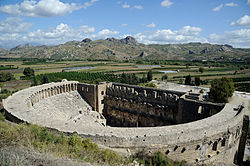 View of the Roman Theatre of Aspendos in 2011 | |
| Location | Aspendos, Turkey |
|---|---|
| Coordinates | 36°56′20″N31°10′20″E / 36.93889°N 31.17222°E |
| Type | Roman theatre |
| Width | 96 metres (315 ft) |
| History | |
| Builder | Zenon |
| Founded | 161 a.D - 180 a.D |
| Abandoned | No |
| Periods | Ancient Rome |
| Cultures | Roman |
| Site notes | |
| Condition | Almost intact |
| Public access | Yes |
The Roman theatre of Aspendos is a Roman theatre in the ancient city of Aspendos in Turkey. It was built in the 2nd century and is one of the best preserved ancient theaters of the Greco-Roman world. [1]
